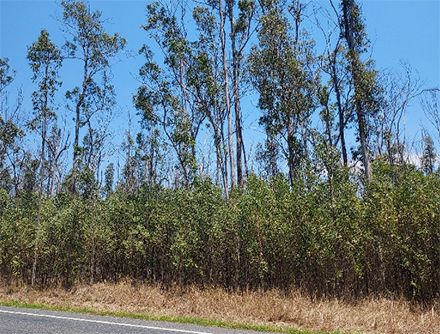
Recent fuels resulting from the 2019/ 20 bushfires in northern NSW, including heavy undergrowth fuels, dead fuels and heavy grass fuel, not safe conditions for firefighting, especially in adverse conditions.
The NSW Rural Fire Service 2022/2023 Annual Report is now on the web it notes that there are a number of achievements to be considered. Source: John O’Donnell
Hazard reduction burning and mechanical removal totalled 90,089 hectares for NSW (Appendix page 100):
- 82,393 ha burning.
- 7,696 ha mechanical.
Unfortunately, areas of annual hazard reduction burning and mechanical reduction in NSW are both at very low rates and vary by year. The areas of fuel reduction in NSW and estimated percentage of forested area based on 20 million hectares of forest in NSW were:
- 147,625 hectares in 2017/ 18 (estimated 0.7 % of NSW forested area);
- 199,248 hectares in 2018/ 19 (estimated 1 % of NSW forested area);
- 55,548 hectares in 2019/ 20 (estimated 0.3 % of NSW forested area);
- 176,499 hectares in 2020/ 21 (estimated 0.9 % of NSW forested area) and
- 44,642 hectares in 2021/ 22 (estimated 0.2 % of NSW forested area).
- 90,089 hectares in 2022/ 23 (estimated 0.5 % (actually 0.045 %) of NSW forested area.
Over time, shortfalls and inadequate fuel reduction add up and result in build-up of very high fuel loads and strata across landscapes. Only 3.6 % of the NSW forested landscape has received fuel treatment over six years, this is extremely low and inadequate to reduce bushfire areas and risk.
Native and plantation forests continue to be heavily exposed to lack of low intensity burns across landscapes, as highlighted in the photos below from the 2019/ 20 bushfires. The data above over six years highlights ongoing miniscule rates of prescribed burning, which is very likely lower in landscapes away from communities.
In addition, where intense bushfires have occurred, such as fuels resulting from the 2019/ 20 bushfires, there are large areas heavy undergrowth fuels, dead fuels and heavy grass fuel, this makes the conditions worse for firefighting, especially in adverse conditions.
In relation to the risk remaining for future fire seasons, it is critical the bushfire risks for future fire seasons are soundly addressed, potentially including increased programs to manage fuels to catch up on shortfall seasons, fully using the additional fire mitigation employees identified in earlier NSW media releases, expanded maintenance burning and other available measures.
There are large opportunities to expand the use of small aircraft, helicopters and drones for low intensity burning operations, using placed grid patterns for fires to join up in the cool of the evening and unburnt patches. There are potential opportunities for a number of prescribed burning drones with individual brigades/ mitigation officers and fire regions.
There are apparent opportunities to increase low intensity burning and mechanical treatment operations by NSW NPWS, noting a level of 71,768 hectares in 2022/23. Noting a land area of 7.6 million hectares, this represents 0.9 % of area treated per year. Using a forest area of 4,812,045, this represents 1.5 % of area treated per year if treatments only addressed forested areas.
There are apparent opportunities to increase low intensity burning and mechanical treatment operations across private lands, noting a level of 4,270 hectares treated across NSW in 2022/23. Using a forest area of 6,937,308 hectares on private lands, this represents 0.06 % of forest area treated per year. There are major apparent opportunities for cooperative fuel reduction and maintenance programs between private landholders and government.
There are apparent opportunities to increase low intensity burning and mechanical treatment operations by local government, noting a level of 4,254 hectares by NSW local government in 2022/23. This had increased from 2021/ 22.
Further detail that highlights low levels of prescribed burning across Australian states is a 2022 article titled “Review of prescribed burning and wildfire burning areas across Australia” which is available at: https://arr.news/2022/05/18/review-of-prescribed-burning-and-wildfire-burning-across-australia-john-odonnell/
Resilient safe, healthy landscapes is a critical issue being considered in many countries across the world, including work in the US on resilient landscapes in relation to bushfires. Considering the extent of chronic eucalypt decline and thick understories in many NSW forests, strategies and actions to address these major issues across NSW landscapes and reduce intense bushfire risks are opportune but overdue, using low intensity maintenance burning and mechanical treatment of forests.
The safety of fire fighters entering forested areas, particularly where there are high fuel loads, is a critical issue, and is a major risk area and has been for a long time.
These matters are raised in order to optimise the safety of firefighting and communities and optimise protection of infrastructure/ assets, forests and the environment. The report is available at https://www.rfs.nsw.gov.au/resources/publications/annual-reports





